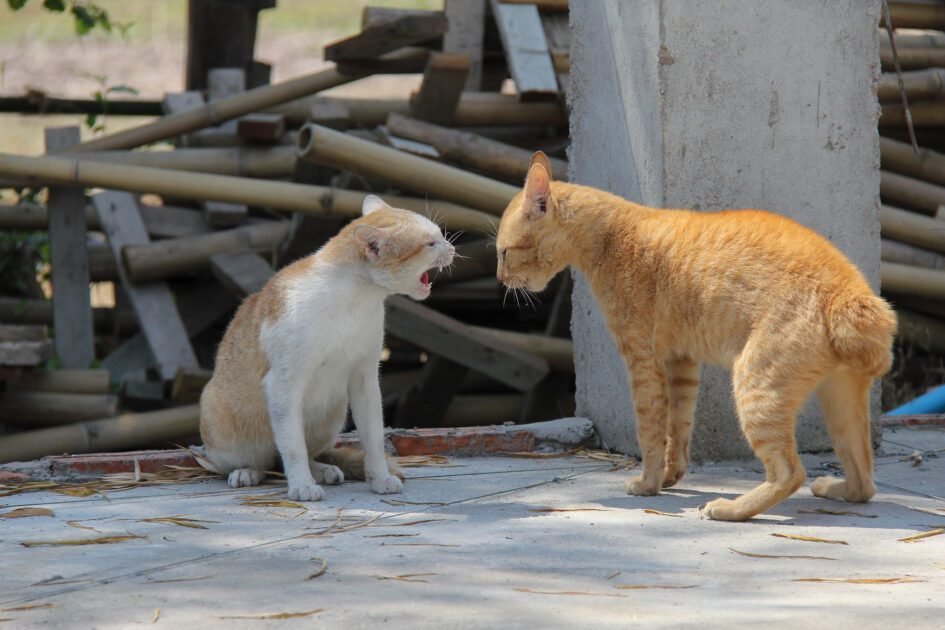


Where Do Cardinals Nest? [Nesting Habits & Behaviour]
December 27, 2023


How To Prevent Cat’s Biting and Humping Behavior?
December 29, 2023No cat owner enjoys seeing their male cat constantly pursuing and assaulting their female cat. This behavior, which can be troubling to observe, leads to questions about what drives it. Although these actions seem random, they typically stem from various instinctive and situational factors.
Male cats often attack female cats for play or dominance, possibly trying to mate. Unneutered males may show increased aggression due to hormones. Sometimes, rough play escalates into fights. Cats, like humans, can also be stressed or anxious, affecting their interactions.
This article will explore the complexities of male cat behavior and advise on maintaining peace among your household cats.
Why Is My Male Cat Attacking My Female Cat: Top 9 Reasons
1: Territorial Behavior
Cats are inherently territorial, a trait stemming from their ancestors. A male cat typically claims an area as his domain, which provides him with a sense of safety and control.
When another cat, particularly a female, enters this space, it can challenge his sense of authority and security. In response, the male may exhibit aggressive actions, including hissing, swiping, and pursuing, or even attacking, to assert his dominance.
This territorial aggression serves as a signal from the male cat, viewing the female as an intruder and showing his readiness to protect his territory.
Related Read: Why Do Birds Attack Cats? Understanding and Prevention
2: Aggressive Fear
Fear aggression can manifest when a cat feels threatened, real or imagined. A scared cat may flee in the wild, but escape options are often limited in a home, prompting a ‘fight’ response. If a male cat perceives a female cat as a threat or feels trapped, he might aggressively defend himself.
Signs of fear aggression include growling, hissing, back arching, ears flattening, and swatting. Even harmless actions or sudden moves by the female cat might provoke this if the male feels endangered.
This type of aggression stems not from hostility but from fear. The male cat’s behavior signals that he feels menaced and will protect himself if pushed.
3: Stress Or Anxiety
Cats thrive on consistency, and any alterations in their surroundings, daily routines, or social groupings can lead to stress or anxiety. This can result in increased irritability, defensiveness, or aggression.
If a male cat is experiencing stress, perhaps from household changes, moving, or new pets, he may take out his frustration on familiar felines, such as a female cohabitant.


Cats Outdoor
Such aggression is typically not targeted but reflects the cat’s inner distress. It’s the cat’s way of coping with an unstable or menacing environment. Consequently, he may misread signals, overreact to external factors, or become overly defensive, causing aggressive encounters.
4: Rough Play
What appears as aggression to us is often rough play among cats. Kittens engage in mock fights involving chasing, pouncing, and wrestling, which are crucial for developing survival skills needed in the wild.
Adult cats frequently continue these rough play activities as a form of exercise, mental stimulation, and interaction with their surroundings. When a male cat seems to be “attacking” a female cat, it could be his way of initiating play.
However, the distinction between play and aggression can become unclear, particularly if the play escalates to excessive roughness. This behavior is part of the intricate social dynamics of cats, where they explore limits, establish social hierarchies, and partake in playful fights.
5: Sexual Aggression
In male cats, particularly unneutered ones, heightened testosterone levels and natural reproductive urges often lead to aggressive behaviors, which might be mistaken for hostility or dominance.
These instincts intensify when he detects a female cat in or near her estrus cycle, prompting him to exhibit behaviors like chasing, pinning her down, biting her neck, and forcefully attempting to mate.
If the female cat is uninterested in estrus, she might respond with resistance signs such as hissing, swatting, or trying to flee. Despite this, the male cat may persist in his advances, which can appear as an aggressive attack on the female. This behavior stems from the male’s strong mating drive rather than a desire to harm.
6: Redirected Aggression
This occurs when a male cat, frustrated by an external stimulus he cannot reach, such as seeing an unfamiliar cat outside, redirects his aggression towards a nearby target, often a female cat in the same household.
This misdirected frustration results in the female becoming an unintended victim of his agitation, even if she didn’t provoke him.
8: Hormonal Aggression
In male cats, especially unneutered ones, hormonal changes can lead to aggression. This is particularly evident when they encounter unspayed female cats, as their natural aggressive and territorial tendencies are amplified.
The male cat’s behavior can be a mix of viewing the female as a mate and a competitor, leading to aggressive interactions.
8: Resource Guarding
Male cats may aggressively guard resources such as food, toys, or sleeping spots against female cats. This behavior is an assertion of dominance and a way to establish boundaries, signaling to the other cat that these resources are off-limits. It’s rooted in survival instincts, where resource protection is crucial.
9: Underlying Medical Conditions
Aggression in male cats can also indicate health issues. Pain, illness, or neurological disorders can lower their tolerance, turning normal interactions with female cats aggressive.


Underlying Medical Conditions in Cats
This is a defense mechanism, signaling a need for space, and is often a symptom of an underlying medical condition rather than a behavioral issue.
Should I Let My Male And Female Cats Fight?
It’s generally not advisable to let your male and female catfight. While some level of rough play is normal and can be a part of their social interaction, actual fighting can lead to injuries, stress, and long-term behavioral problems.
Here are some steps you should consider to make them stop fighting:
- Understand the Cause: Determine if the behavior is playful or aggressive. Playful interactions are usually reciprocal and don’t result in harm, whereas aggressive encounters often involve hissing, growling, or one cat trying to escape.
- Intervene Safely: If it’s aggression, intervene safely. Don’t try to physically separate them with your hands, as this could result in injury. Instead, try to distract them with a loud noise or throw a soft object near them to break their focus.
- Provide Separate Spaces: Give each cat space with separate resources like food bowls, litter boxes, and resting areas. This can reduce competition and stress.
- Neutering/Spaying: If you still need to, consider neutering or spaying your cats. This can significantly reduce aggressive behavior, especially related to mating or hormonal aggression.
- Slow Reintroduction: If aggression is frequent, separate the cats and reintroduce them slowly, under controlled and supervised conditions. This can help them re-establish a more peaceful relationship.
- Consult a Vet or Behaviorist: If the aggression persists or worsens, consult a veterinarian to rule out medical issues or a professional animal behaviorist for tailored advice.
Can Both My Male And Female Cats Live Together In Peace?
Yes, male and female cats can live together harmoniously, but this depends on their personalities, socialization, and whether they are spayed or neutered.
Here are some key points to consider for a peaceful cohabitation:
- Spaying and Neutering: This is crucial. Spaying (for females) and neutering (for males) reduce hormonal-driven behaviors like territorial aggression, marking, and the stress of mating behaviors. This can lead to a more peaceful environment.
- Proper Introduction: Introduce cats to each other gradually and under controlled conditions. This helps prevent initial aggression and anxiety, allowing them to get used to each other’s presence slowly.
- Individual Space: Ensure each cat has space, including litter boxes, feeding areas, and resting spots. This helps reduce competition and stress.
- Environmental Enrichment: Provide ample stimulation through toys, climbing structures, and interactive play. This helps keep them mentally and physically stimulated, reducing the likelihood of boredom-induced aggression.
- Monitor Interactions: Monitor how they interact, especially in the early stages. Look for signs of aggression or stress and intervene if necessary.
- Consistent Routine: Cats thrive on routine, so maintaining a consistent schedule for feeding, play, and relaxation can help reduce stress and conflict.
- Behavioral Training and Socialization: Encourage positive interactions through rewards and training. Early socialization, especially for kittens, can also lead to better cohabitation.
- Regular Health Check-ups: Regular veterinary care ensures that any health-related issues that might cause irritability or aggression are addressed promptly.
Conclusion
Living with both male and female cats requires careful management, mainly when dealing with aggression, which can stem from various causes like territorial disputes or hormonal influences. Identifying these causes is crucial for maintaining a peaceful home.
It’s important to closely watch how they interact and be ready to step in at the first sign of conflict to prevent any escalation.
Achieving a harmonious environment takes effort and patience, but the rewards are significant. With careful planning and ongoing monitoring, male and female cats can live together peacefully, adding joy and companionship to the home.



